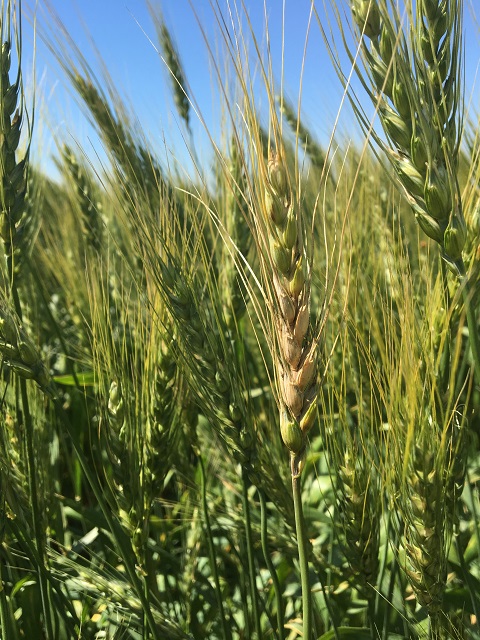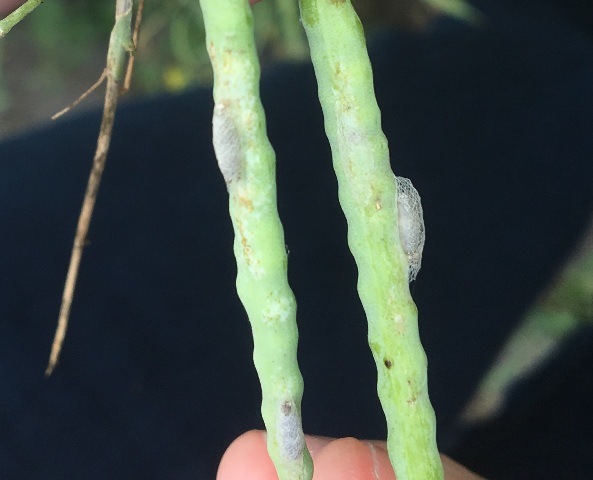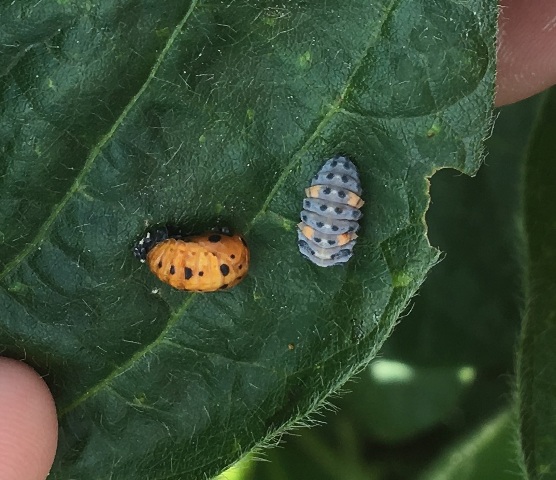Manitoba Insect & Disease Update
Issue 11: August 2, 2017
Summary
Insects:
Diamondback moth continues to be a concern in some areas, although it is the pupa stage that is now dominant in some fields.
Soybean aphids surpassed economic threshold in some fields. In some soybean fields natural enemy populations seem to be building in response to the soybean aphids.
Bertha armyworms are being monitored, and high levels of larvae have been reported from the Holland and Austin areas.
Pathogens:
Phytophthora root rot reports in soybeans continue to come in from across the province.
Fusarium head blight symptoms are evident in some fields, but overall incidence remains low.
Phytophthora Root Rot
Reports of root rot, suspected be Phytophthora, have continued to come in from across the province. In severe cases, up to 50% of plants have shown disease symptoms. Plants infected with Phytophthora root rot (PRR) will typically completely senesce and not produce yield. The spores of the causal pathogen are long-lived in the soil, so rotation alone will not be enough to manage the disease in future years. Seed treatments can be used to manage disease early in the season, and resistant varieties are key to managing PRR. Provincial surveys have indicated what races of PRR are present in Manitoba and resistant varieties are indicated in Seed MB with what resistance gene they carry.
Table 1. Current races of PRR detected in Manitoba and the resistance genes that are effective against those races.
Race of PRR |
Resistance Genes Effective |
|---|---|
4 |
1b, 1d, 1k*, 3a*, 6* |
25 |
1d, 3a*, 6* |
28 |
1c*, 1d, 3a*, 6* |
3 |
1b, 1c*, 1d, 1k*, 3a*, 6* |
*Indicates resistance genes currently available in Manitoba (see Seed MB)
Fusarium Head Blight
The provincial survey for Fusarium head blight (FHB) in spring wheat is underway and almost complete across the province. In most fields, infection is extremely low. Symptoms are more easily observed in fields that received a rainfall in early July. FHB ratings are also performed in MCVET trials across the province which do not receive a fungicide application. Disease levels in these trials in 2017 have also been low overall.

Figure. Fusarium head blight symptoms in spring wheat.
Diamondback moth
Some insecticide applications have occurred for diamondback moth. The economic threshold once we get into the late-flowering and podding stages is if larvae exceed 20-30 per ft2. Make sure economic populations of larvae are present before deciding to apply insecticides. In some of the fields in the Carman area the majority of the population is now in the pupae stage, with very few larvae remaining. So even if pod feeding is noticed, make sure economic populations of larvae are present. They likely will be another generation of larvae, but this may be too late to be of concern for most fields, but something to watch in late seeded fields. Sometimes populations remain high into the later generations, other times populations will decline due to natural enemies or weather.
If insecticide applications are necessary for diamondback moth in canola, remember to consider the preharvest interval (which is the time until swathing) of insecticides. Most are 7 days or less, but chlorpyrifos has a 21 day preharvest interval, and may not be an option for some fields.

Fig. 1. Diamondback moth pupae on canola pods.
Soybean Aphids
Soybean aphids have reached economic threshold, and insecticides have been applied in some fields. In many fields, natural enemy levels are starting to build, which is making the decision making tricky. The Aphid Advisor app can be a useful tool to help factor natural enemies into the decision making process: http://www.aphidapp.com/.
The economic threshold for aphids is 250 per plant on average and the population is increasing, and the plants are in the R1 (beginning bloom) to R5 (beginning seed) growth stages. This threshold provides about a 7-day lead time before aphid populations are expected to exceed the economic injury level (670 aphids per plant), where cost of control is equal to yield loss.
Estimating yield loss from soybean aphids: Regarding what amount of yield loss to expect from high populations of soybean aphids, the studies that were the basis for the economic threshold provide information on this. The unit used to measure aphid feeding is the study is called aphid-days; an aphid-day being one aphid feeding for one day. Ten aphid-days could be 10 aphids feeding for one day, or 1 aphid feeding for 10 days. The studies found that yield was reduced by 6.88% for every 10,000 aphid-days accumulated (Journal of Economic Entomology. 2007: 1258-1267). So if there were 500 aphids per plant on average, feeding for 20 days, a yield loss of roughly 7% could be expected.
Forms for Diagnostics
A reminder that when either a photo or sample is submitted to Manitoba Agriculture for an insect, pathogen, weed or crop damage to be identified, a diagnostic form needs to be submitted with the photo or sample. The forms are available electronically at the following link: http://www.gov.mb.ca/agriculture/crops/crop-diagnostic-services/index.html
A photo or sample of a pathogen or insect without background information on where it was found (legal location or nearest town), and on what crop, can result in extra work for those making the diagnosis. As is indicated, samples may not be processed if vital information is not provided on the diagnostic form, or if a form is not provided. This includes photos which are sent by Email for identification of insects, pathogens, weeds, or plant damage.
Insect Monitoring Programs
Bertha Armyworm: Four traps from western Manitoba have cumulative counts for bertha armyworm in the uncertain risk range (300-900 moths). The other 86 traps are all in the low risk range (less than 300 moths). The highest concentrations of moths captured in the traps have been in the Benito and Durban areas in the Northwest.
Levels of larvae of bertha armyworm can vary greatly between fields within a region, and should higher levels of larvae occur in a region these higher levels of larvae may not be in the same fields as traps with the highest counts. This is due to the stage of the crop at the time of egg laying and other factors. Thus the data from these traps should not be used to make control decisions for bertha armyworm, but to encourage enhanced scouting for larvae in regions with higher trap counts.
Highest counts of bertha armyworm moths were:
Table 1. Highest cumulative trap counts for bertha armyworm adults over the trapping period June 4 to July 29, 2017.
0-300=low risk 300-900=uncertain risk 900-1,200=moderate risk 1,200+=high risk
| Location | Region | Count | Risk |
|---|---|---|---|
| Benito | Northwest | 605 | Uncertain |
| Tilston | Southwest | 413 | Uncertain |
| Durban | Northwest | 371 | Uncertain |
| Benito | Northwest | 329 | Uncertain |
| Durban | Northwest | 297 | Low |
| Glenboro | Central | 294 | Low |
| Benito | Northwest | 282 | Low |
| Napinka | Southwest | 276 | Low |
| Pilot Mound | Central | 253 | Low |
| Lenore | Southwest | 241 | Low |
| Roblin | Northwest | 237 | Low |
| Miniota | Southwest | 212 | Low |
A more detailed update of bertha armyworm counts in Manitoba is available on the Manitoba Agriculture website at: http://www.gov.mb.ca/agriculture/crops/insects/bertha-armyworm-forecast.html
For those monitoring trap, the traps can now be pulled. July 23 to 29th was the last week for data collection.
Insect Identification Quiz
These insects are quite common in some of the field crops currently. When you poke at them, they will not move, other than possibly raising their front end. What are they?

The insect on the left is the pupae stage of a lady beetle.
The insect on the right still looks like a lady beetle larva, but has started the process of becoming a pupa. It has fastened itself to the leaf, and will some be transformed into a pupa. Neither of these will feed, however one they become adult lady beetles they will resume their aphid feeding habits.
----------------------------------------------------------------------------------------------------------------------
Compiled by:
John Gavloski, Entomologist Holly Derksen, Field Crop Pathologist
Manitoba Agriculture Manitoba Agriculture
Phone: (204) 750-0594 Phone: (204) 750-4248
To report observations on insects or plant pathogens that may be of interest or importance to farmers and agronomists in Manitoba, please send messages to the above contacts.
To be placed on an E-mail list so you will be notified immediately when new Manitoba Insect and Disease Updates are posted, please contact John Gavloski at the address or numbers listed above.
